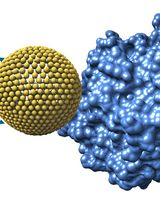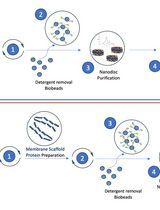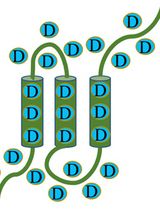- EN - English
- CN - 中文
Analysis of L- and D-Amino Acids Using UPLC
采用UPLC分析L-氨基酸和D-氨基酸
发布: 2014年09月05日第4卷第17期 DOI: 10.21769/BioProtoc.1231 浏览次数: 13880
Abstract
With the exception of glycine, α-amino acids are optically active, and two optical isomers (L- and D-) of each amino acid can be formed. Recent developments of analytical techniques have revealed that several free D-amino acids such as D-aspartate, D-serine and D-alanine exist in many kinds of organism including human and have biologically important roles. D-Aspartate regulates reproductive activity in animals and humans. D-Serine serves as a co-agonist of the N-methyl-D-aspartate receptor, which mediates glutamatergic neurotransmission. D-Alanine plays a role like osmolyte in crustaceans and mollusks. In this protocol, we describe a method for analysis of L- and D-amino acids using ultra-performance liquid chromatography (UPLC). To analyze D- and L-amino acids, the enantiomers are initially converted into diastereomers (diastereomers are stereoisomers that are not related as object and mirror image and are not enantiomers) using pre-column derivatization with o-phthaldialdehyde plus N-acylated cysteine (N-acethyl-L-cysteine or N-tert-butyloxycarbonyl-L-cysteine). The resultant derivatives are fluorescent diastereomers. This is followed by separation of the resultant fluorescent isoindol derivatives on an octadecylsilyl stationary phase using UPLC, and the fluorescence is detected by a fluorescence detector included in UPLC system. Using this method, 16 kinds of D-amino acid can be analyzed.
Materials and Reagents
- N-Acetyl-L-cysteine (NAC) (Wako Pure Chemical Industries, catalog number: 017-05131 )
- N-tert-butyloxycarbonyl-L-cysteine (NBC) (Funakoshi, catalog number: 04-621 )
- o-Phthaldialdehyde (OPA) (Nacalai Tesque, catalog number: 27824-74 )
- Methanol (Wako Pure Chemical Industries, catalog number: 132-06471 )
- Acetonitrile (Wako Pure Chemical Industries, catalog number: 015-08633 )
- Trichloroacetic acid (Wako Pure Chemical Industries, catalog number: 203-04952 )
- Sodium hydroxide (Wako Pure Chemical Industries, catalog number: 192-15985 )
- 0.4 M sodium borate buffer (see Recipes)
- 50 mM sodium acetate buffer (see Recipes)
- Acetic acid (Wako Pure Chemical Industries, catalog number: 192-01075 )
- Sodium acetate (Wako Pure Chemical Industries, catalog number: 192-01075)
- Acetic acid (Wako Pure Chemical Industries, catalog number: 192-01075 )
- 50% TCA (see Recipes)
- 1 M NaOH (see Recipes)
Equipment
- ACQUITY UPLC-FLR system (Waters)
- AccQ-Tag Ultra 2.1 x 100 mm column (Waters, catalog number: 186003837 )
- ACQUITY binary solvent manager
- ACQUITY sample manager
- ACQUITY FLR detector
- Sample vial: 12 x 32 mm glass screw neck vial, Quick Thread, LectraBond cap, PTFE/silicone septa, Total Recovery (Waters, catalog number: 186000384c )
- Empower 2 software
- AccQ-Tag Ultra 2.1 x 100 mm column (Waters, catalog number: 186003837 )
- Vortex (Taitec, catalog number: 0061271-000 )
- Polytetrafluoroethylene membrane filters (4-mm diameter, 0.2-μm pore size) (Merck KGaA, catalog number: SLLGH04NL )
- Amicon Ulta 0.5 ml centrifugal filter 3 K device (Merck KGaA, catalog number: UFC500396 )
Software
- Empower 2 software
Procedure
文章信息
版权信息
© 2014 The Authors; exclusive licensee Bio-protocol LLC.
如何引用
Mutaguchi, Y. and Ohshima, T. (2014). Analysis of L- and D-Amino Acids Using UPLC. Bio-protocol 4(17): e1231. DOI: 10.21769/BioProtoc.1231.
分类
生物化学 > 蛋白质 > 荧光
生物化学 > 蛋白质 > 结构
您对这篇实验方法有问题吗?
在此处发布您的问题,我们将邀请本文作者来回答。同时,我们会将您的问题发布到Bio-protocol Exchange,以便寻求社区成员的帮助。
Share
Bluesky
X
Copy link












